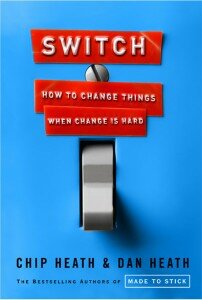So much content marketing, so little change
“Why Content Marketing Is King,” touted a story last week about a recent business survey. There’s no denying the need for quality content. But for many of us marketers, elevating content to royalty distracts us from the work that should matter most: creating behavioral change.
My consulting practice centers on progressive businesses and nonprofits that are trying to change the world, their organization or their stakeholders in ways large and small. We all know from experience that personal change can be hard. So it’s no surprise that trying to influence change in others can seem impossible or painstakingly slow. And if we’re not careful as marketers, throwing more content at the problem will only make matters worse.
The world is drowning in content generated by marketers — blog posts, case studies, white papers, ebooks, videos, photos — and the social media meant to publicize and disseminate the content. It’s axiomatic in marketing circles that awareness precedes action. Some content is aimed at creating initial awareness. Other content is produced to generate leads, establish thought leadership or deepen customer loyalty. Too often, however, the marketing objective becomes producing more content instead of the change we seek.
Bridging the say-do gap
Content marketing conforms perfectly to marketing’s traditional role of providing the customer or audience with all the information they need to act. Thanks to digital and social everything, what’s changed is our ability to cost-effectively create, deliver and promote content in multiple forms, across multiple channels and track who and how many access our content. And with news media in decline, marketers can no longer rely on editors and reporters to pick up and run with their stories. Getting the word out depends more than ever on filling the content developer void left by the news media.
So it’s easy to see why content production and distribution is becoming the largest piece of the marketing pie. But is all this informative and entertaining content making a difference? When it comes to sustainability, for instance, research shows a large say-do gap. Among its results, a 2010 Yale study found:
- 88 percent of Americans say it is important to recycle at home, but only 51 percent “often” or “always” do
- 81 percent say it is important to use re-usable shopping bags, but only 33 percent “often” or “always” do
- 76 percent say it is important to walk or bike instead of driving, but only 15 percent “often” or “always” do
Clearly, most Americans are aware of the importance of certain “green” behaviors. We’re just not doing what we say is important. The Persuasive Tech Lab at Stanford University offers up the Top 10 Mistakes in Behavior Change. Number 7? “Believing that information leads to action. We humans aren’t so rational.”
We don’t simply need more information. We need help bridging awareness into action. This strikes me as the new frontier for marketers: creating behavioral change — not just content for content’s sake.
‘Make people feel something’
“Knowing something isn’t enough to cause change,” say Chip and Dan Heath, brothers and authors of Switch: How to Change Things When Change Is Hard. “Make people feel something.”
People have a rational side and an emotional side, and those wanting to create change have to reach both, the Heaths argue: “But when it comes time to change the behavior of other people, our first instinct is to teach them something.”
In other words, we produce more content and feed it to the rational side. That’s the easy part. The harder part — and the part marketers need to master — is recognizing, finding and connecting to the emotional side of our audience in ways that influence and inspire concrete change. Not just through clever communications but by learning and deploying behavioral change techniques.
In Switch, the Heaths lay out a three-step template for creating change:
- direct the rational side by cloning what’s working, scripting specific behaviors, pointing to the destination
- motivate the emotional side by finding the feeling, shrinking the change so it’s less daunting, instilling a growth mindset
- shape the path by tweaking the environment or changing a situation, building new habits, capitalizing on the tendency for behavior to be contagious
Of course, you’ll need to read the book to fill in the many blanks in this template. But notice the strategies listed here. It’s not simply a process of producing more and better information. It’s understanding how to stimulate and guide change in others. And tapping into the whole person, the rational and the emotional.
For those of us whose measure of success is positive change, being a purveyor of content is not enough. Content untethered from proven strategies for creating change renders marketing ineffective. If you want your marketing to reach greatness, learn how to create change. And let that be the king of your content marketing.

